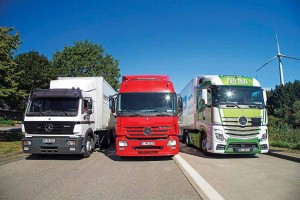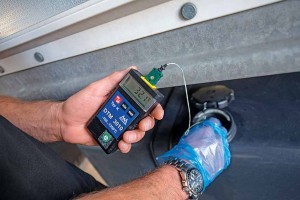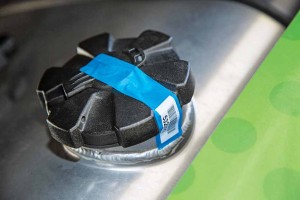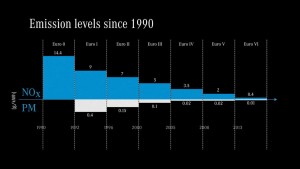A comparison between trucks made across tightening Euro emission standards has revealed startling results.
Story by: Team CV

The BSVI emission standard in India is three years away. It is comparable to the Euro6 emission standard, that came into force in Europe in 2014. As the Indian commercial vehicle industry warms up to the enforcement of BSIV emission standard pan-India by April 2017, and BSVI by mid-2020, a comparison of trucks in Europe has revealed how they have performed in terms of fuel efficiency and emissions as they progressed through the Euro emission standards. A comparative test drive certified by the test organisation Dekra in August 2016 saw three Mercedes-Benz trucks from 1996, 2003 and 2016 respectively being put through their paces on the demanding and universally recognised test circuit of the commercial vehicle magazine ‘Lastauto Omnibus’ in Germany.
The test circuit, a long distance route from Stuttgart to Hamburg and then to Stuttgart, has been used by Mercedes-Benz to carry out in-house test drives. ‘Lastauto Omnibus’ carried out an independent and exhaustive test drive under the watchful eye of Dekra. Dekra took part in this three-generation truck comparison as an independent test organisation. The test verification was particularly appropriate because the positive development in the fuel consumption of heavy trucks is currently under constant scrutiny by politicians. The test was structured to measure the on-road fuel consumption and mileage according to the test manager Frank Zeitzen. They included test vehicles that have been identically prepared as far as possible, and with highly experienced truck test journalists at the wheel. The test drivers took turns behind the wheel after each test round, and the semitrailers were changed every day. Doing this ensured the trailers being towed were used the same number of times by each tractor (prime mover). This would eliminate any difference in the rolling characteristics.


Mercedes-Benz Actros

Attention to detail
The semitrailers were identically loaded and had the same tyres. For the three-generation comparison, three box semitrailers were loaded to an identical 32-tonnes. They were fitted with the same tyres. To reflect the progress made in rolling characteristics, the basic Mercedes-Benz SK 1844 truck from 1996 was shod with the then popular Michelin XZA/XDA tyres of size 295/80-22.5. The second test truck, the Actros 1846 (from 2003) was fitted with tyres from the Michelin Multiway family, in size 315/70-22.5. The latest Actros 1845 Euro VI truck was fitted with factory-fresh Michelin tyres in size 315/70-22.5. Where the mileage of the test vehicles is concerned, the new Actros Euro VI truck was at a slight disadvantage. With just over 8000 km on the clock, it was not yet quite run-in. The best fuel economy thanks to minimised resistances within major assemblies is normally to be expected after around 50000 km. The Actros 1846 Euro3 (from 2003) used in the test was thoroughly run-in at 55000 km. The 20 year-old, Euro2 Mercedes-Benz SK 1844 had an odometer reading of 610,000 km. The cruising speed and overshoot, and undershoot times for downhill and uphill gradients were defined and monitored by the recording personnel. Conventional cruise control was used to ensure a consistent cruising speed for the two older trucks. In the latest Actros this was taken care of by the Predictive Powertrain Control (PPC) system. Six measuring rounds of 256 km were absolved on the test circuit. The test drivers changed vehicles after each measuring run, and the 32-tonne trailers were also exchanged in accordance with the assigned driver. Every evening the vehicles were refuelled under precise, temperature-compensated conditions.
Attention to detail
The highly precise test preparation and execution proved to be of much practical relevance. Especially when one would consider that the test would be held on a comparatively demanding circuit when compared to the classic Stuttgart-Hamburg-Stuttgart test route used by Mercedes-Benz to measure trip consumption. The test procedure banked upon what the participants would call as the ‘Vecto’. By ‘Vecto’ they meant ‘Vehicle Energy Consumption Calculation Tool’. Major input data was measured and subsequently processed using a calculation tool officially provided by the European Commission. The test course to be used was defined by the representative of European long-distance operations in a very involved process. For example, the aerodynamic drag of every single cab variant of a truck model was measured on the road by independent test organisations. The same applied to the rolling resistance of tyres. Tyre manufacturers were called to demonstrate the rolling characteristics of their product lines. For example, different sizes, substructures and tread patterns. Where the powertrain consisting of the engine, transmission and drive axles were concerned, the manufacturer was called upon. The same was the case with the cab.

The outcome
At the end of the test, it was revealed that despite drastically more stringent emission standards for nitrogen oxides and particulates, the fuel consumption of heavy trucks has gone down by 22 per cent over the last 20 years. The model 1844, certified according to Euro2 standard valid in 1996, was allowed to emit seven grams of NOx per kilowatt hour (kWh) while staying within the limiting value of 0.15 g/kWh for particulate matter. The number and size of the soot and other particles was not prescribed. The Actros 1846 (of 2003) was certified according to emission standard Euro3, with five grams of NOx per kilowatt hour (kWh) and 0.10 g/kWh of particulate mass. The latest-generation EuroVI Mercedes-Benz Actros 1845 betters the older Euro3 truck by 94.3 per cent (NOx, present limit 0.4 g/kWh) and 96 per cent (0.01 g/kWh) for particulate mass. The current measuring conditions are far more stringent. Daimler sources claim that the (22 per cent) reduction in fuel consumption has resulted in savings of more than 50 million tonnes of CO2 by Mercedes-Benz trucks in Europe since 1996. They draw attention to how the calculation is done, and on what parameters. They add, sales of around one million Mercedes-Benz trucks in the segment of long-distance transport in Europe between 1996 and today, as well as a conservative estimate for the annual mileage of 75000 km per vehicle, and a service life of eight years led to this estimation. The current fuel consumption per 100 km measured during the certified Dekra test run for the years 1996, 2003 and 2016 is extrapolated on a linear basis for the other years.
Against a background of drastically reduced emission levels in the ‘traditional’ pollutant categories, the actual on-the-road consumption for the test covering 1536 km on a demanding topography with a test weight of 40 tonnes turned out the following results: The 20 year-old Mercedes-Benz SK (model 1844) reached a figure of 40.8-litre per 100 km. The Actros 1846 Euro3 truck consumed 37.4-litre per 100 km, and the Euro6 Mercedes-Benz Actros 1845 consumed a meagre 31.9-litre per 100 km. All this, over an identical route and distance. Interestingly, the exhaust emission reduction from Euro2 in 1996 to the current Euro6 has been a drastic 96 per cent.




















